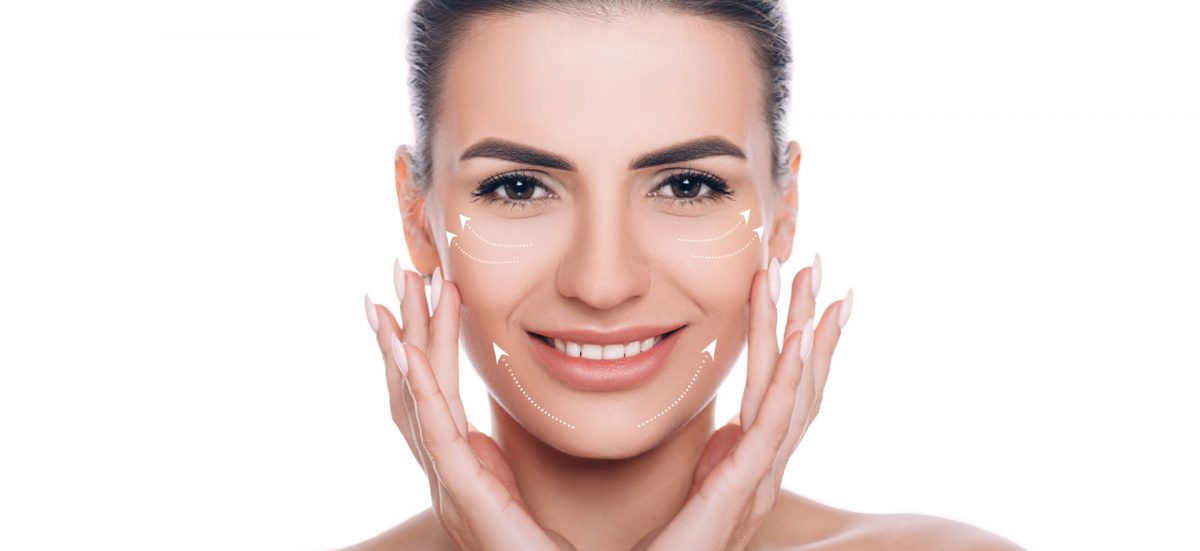Non-Surgical Facelift Using Tensor Threads (Thread Lift)
Lift loose skin tissue
Tensor threads date all the way back to the 60s. At the time, plastic surgeons used loop-knotted sutures to lift loose skin tissue. In the 2000s, a plastic surgeon of Russian origin, Dr. Sulamanidze, had the idea of notching the surgical thread used in procedures to better anchor the tissue. This approach caused unsightly results and uncomfortable side effects and the technique was soon abandoned.
Subcutaneous absorbable threads have been used in recent years. Their effect is twofold: they tighten the structures of the skin while stimulating natural collagen biosynthesis. This renews the skin while being well-tolerated and offering minimally invasive positioning. Different threads are used, depending on the desired level of traction: mono, notched or coned (uni-directional or bi-directional).
Approved by Health Canada, Silhouette InstaLift™ bioabsorbable tensor threads tighten sagging skin of the face and neck and support collapsed subcutaneous tissue. They produce a lifting effect without the need for surgery, by inserting threads (equipped with anchors, knots and cones) under the skin. This makes it possible to combat the sagging that develops with age (tissue ptosis) by lifting the skin.
The threads also trigger natural tissue repair mechanisms and encourage the body to produce new collagen, elastin and hyaluronic acid, resulting in improved skin texture, tone and elasticity.
The ideal candidate usually has early sagging of the oval of the face, neck or neckline, often seen in men and women around 40 to 50 years of age. People whose skin has significantly slackened (ptosis) or lost tone should opt for a surgical facelift or a deep peel instead, otherwise they may be disappointed with the results.
A thread lift can redraw the oval of the face, lift the jowls, smooth bitterness furrows and deep nasolabial folds. It can also improve a sad or tired appearance caused by sagging cheeks or drooping eyebrows.
This procedure can be used as an alternative to a conventional facelift for clients who prefer a non-surgical procedure or when surgery is contraindicated.
– Suitable for all skin types
– Ideal for both men and women
– No general anaesthesia or incisions required
– Shorter recovery period, with minimal bruising
– Results that last about two years
– Fraction of the cost of a surgical facelift
Some conditions can hinder optimal healing and desired outcomes.
Pregnancy, nursing, a local infection, cancer, a history of poorly controlled diabetes, an autoimmune disease, thick scars or blood clotting issues are all contraindicated.
Sun exposure is not contraindicated, but should be avoided while the skin heals after the procedure. Thread lifts can be performed at any time of year.
An initial examination is conducted to assess the client’s state of health and skin to determine if they are a good candidate for the procedure and if this technique is the most appropriate for their needs.
First, the face is examined to determine how many threads are needed and how they should be placed. A preliminary pathway is traced to ensure optimal results. Then, a little local anesthetic is injected at the intended entry and exit points.
Most of the threads are inserted under the skin using a simple, fine, flexible microcannula, which does not leave any scars.
The thread lift technique is both an alternative and a complement to minimally invasive rejuvenation techniques, like the injection of volumizing agents (hyaluronic acid, Juvéderm, Stylage, Restylane) or neuromodulators (Botox, Xeomin, Dysport). It takes advantage of the body’s natural healing processes.
It is a new dual-action aesthetic rejuvenation technique that makes you look younger by:
– immediately lifting sagging skin from the middle part of the face; and
– gradually restoring skin volume and positioning by stimulating natural collagen production.
It is both innovative and appealing because it requires no surgery or incisions, therefore leaving no scars.
Silhouette InstaLift™ tensor threads are made of 82% poly-L-lactic acid (PLLA) and 18% polylactic-co-glycolic acid (PLGA), both of which are biocompatible.
You will be able to resume your normal activities on the day of the procedure if you wish. Expect mild discomfort, redness or bruising for two to five days as you recover. Avoid demanding activities for a few weeks, if possible.
Small bruises (about 10% of cases) and mild edema (swelling) may occur.
Small bumps or irregularities can sometimes be visible, especially where the threads end. These will gradually be absorbed.
Asymmetry is possible, especially if already present before the procedure. Makeup can be applied, but it is best to wait 24 hours.
An infection is always a possibility, but very uncommon if the care instructions are followed. You will be provided with the necessary documentation.
It may be desirable to have additional threads inserted, usually after three months, to complete the process.
The threads will be fully absorbed within 12 months. While you will see immediate results right after the procedure, they will continue to improve over a period of three to four months.
Occasional maintenance in required because the skin and soft tissues will continue aging. However, the results can be considered semi-permanent, since they last for more than 48 months. It all depends on how your body reacts to the threads.
Most people who have undergone a thread lift choose to resume their normal activities the day after the procedure. There may be some discomfort.
Avoid using skin treatments like IPL, laser or radiofrequency for six to 12 weeks.
Cost per thread / per cheek 500 $ Taxes are not included.
Results may vary from person to person.
Before-after pictures unretouched.
The pictures are not a guarantee of results.








